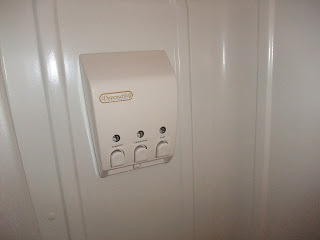
Having pulled our Xantrex Freedom 458 2kw inverter/charger out of the Tioga before selling it, we recently installed it in the Nashinator. Our Xantrex was used when we bought it, which is a good thing because they sell for over $1000 new. For those curious minds, an inverter converts 12v dc into 120vac. A 2000w inverter can give you 15 amps of AC. The Xantrex 458 is also a 3-stage charger with a 150A max output, so it can recharge our (2) golf cart batteries in short time. I pulled 4 awg cable directly from the inverter to the batteries mounted on the trailer's A-frame. These cables were fed under the wood floor, but above the under panel where the insulation is.
Since I wired the inverter into the "general purpose" AC circuits, we now have the ability to plug pretty much anything into an AC outlet and get power without being plugged into street power or running a generator. This is pretty cool to have AC power anytime you want, without the noisy generator running.. Of course the limitation is how much amp-hour capacity you have in your batteries. It does not power the air condinioner, the microwave, or the water heater's 120v element.
The boring math:
Our (2) 6v golf cart batteries have a capacity of 210 ah (amp-hours) when fully charged. But you shouldn't discharge these batteries more that 1/2 of its max capacity, so really it's 100ah of available capacity. (That's 100 amp for one hour, or 1 amp for 100 hours)
For every 1 amp of AC power needed, it draws 10 amps from the batteries. (Power=Amps X Volts)
Kyle's 19" LCD TV/DVD combo draws around 30w, or 0.25amps. So for every hour he watches TV, we'd use up 0.25ah of AC power, but 2.5a DC power. If Deb and I are also watching a movie on the laptop, that's 90w (0.75a)/hr AC. So using both, we consume 10 amps/hr from the battery.
But you also have lights (20w), water pump (40w), and (gulp) the furnace (80w) and coffee maker (650w). So based on a "typical" conservative day of dry camping, one might expect to use around 90 amp-hours per day, which is most of the battery capacity you can use.
You can reduce this consumption in several ways:
- Add a solar panel. If you read my previous blog, our 120w panel can provide up to 7 amps per hour, but realistically let's say 3-5 amps average depending on light. Over an eight-hour period of reasonable daylight, that gives you back 30 ah's per day. So now that 90 ah/day consumption drops to 60.
- Go to LED lighting. Those little incandescent lamps really add up. (4) 20w lights running 3 hours per day, consume 20 ah/day. I went to LED lamps that plug right into the sockets and they only draw 3 watts each. so now I'm saving another 17 ah/day dropping daily draw to 43 ah/day.
- Use a percolator or french press for coffee vrs an electric drip machine. Save another 13.5 ah/day, so now we're down to 30ah draw.
- Use a catalytic heater instead of a furnace. Save 13 ah/day. Now down to 17 ah draw/day. These puppies put out a lot of heat and only use propane. We have a "Mr. Heater" portable unit, which needs to be used only with ventilation. The popular brand for RV are the Olympian Wave heaters, which are very safe, but are a more permanent installation and space, which we don't have.
But then all of this is somewhat optimistically theoretical, because there are other losses that draw down such as LP and CO2 detectors, fridge lights, and water heater controllers. A cool thing to have is a Bogart Trimetric Power monitor (see photo-upper). This puppy accurately tracks your rig's % full, voltage, amperage, and/or watts. A very handy tool when dry camping to see what's going on. We also have a Xantrex Control module (center) mounted in the same location which gives you battery status as well as full control over what the inverter is doing. For example, the inverter draws battery amps even when unloaded, so at night or when gone we can turn it off.
The inverter and solar charge controller are mounted under the front seat of the Nash 17c's dinette. This was otherwise somewhere dead space.
Electrical System Before Conversion
Electrical System After Conversion
The replacement LED lamps I am using
Here are some good sites with much more detail on dry camping


























